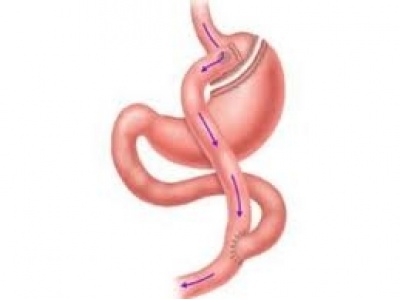
- Gastric bypass procedures (GBP) are any of a group of similar operations that first divides the stomach into a small upper pouch and a much larger lower "remnant" pouch and then re-arranges the small intestine to connect to both. Surgeons have developed several different ways to reconnect the intestine, thus leading to several different GBP names. Any GBP leads to a marked reduction in the functional volume of the stomach, accompanied by an altered physiological and physical response to food.
he gastric bypass, in its various forms, accounts for a large majority of the bariatric surgical procedures performed. It is estimated that 200,000 such operations were performed in the United States in 2008. An increasing number of these operations are now performed by limited access techniques, termed "laparoscopy".Laparoscopic surgery is performed using several small incisions, or ports: one to insert a surgical telescope connected to a video camera, and others to permit access of specialized operating instruments. The surgeon views his operation on a video screen. Laparoscopy is also called limited access surgery, reflecting the limitation on handling and feeling tissues and also the limited resolution and two-dimensionality of the video image. With experience, a skilled laparoscopic surgeon can perform most procedures as expeditiously as with an open incision—with the option of using an incision should the need arise.
This variant is the most commonly employed gastric bypass technique, and is by far the most commonly performed bariatric procedure in the United States. The small intestine is divided approximately 45 cm (18 in) below the lower stomach outlet and is re-arranged into a Y-configuration, enabling outflow of food from the small upper stomach pouch via a "Roux limb". In the proximal version, the Y-intersection is formed near the upper (proximal) end of the small intestine. The Roux limb is constructed using 80–150 cm (31–59 in) of the small intestine, preserving the rest (and the majority) of it for absorbing nutrients. The patient will experience very rapid onset of the stomach feeling full, followed by a growing satiety (or "indifference" to food) shortly after the start of a meal.
Variations of the gastric bypass
Gastric bypass, Roux en-Y (proximal)Gastric bypass, Roux en-Y (distal)
The small intestine is normally 6–10 m (20–33 ft) in length. As the Y-connection is moved further down the gastrointestinal tract, the amount available to fully absorb nutrients is progressively reduced, traded for greater effectiveness of the operation. The Y-connection is formed much closer to the lower (distal) end of the small intestine, usually 100–150 cm (39–59 in) from the lower end, causing reduced absorption (malabsorption) of food: primarily of fats and starches, but also of various minerals and the fat-soluble vitamins. The unabsorbed fats and starches pass into the large intestine, where bacterial actions may act on them to produce irritants and malodorous gases. These larger effects on nutrition are traded for a relatively modest increase in total weight loss.
"Mini-gastric bypass" (MGB)
The mini gastric bypass procedure was first developed by Dr Robert Rutledge from the USA in 1997, as a modification of the standard Billroth II procedure. A mini gastric bypass creates a long narrow tube of the stomach along its right border (the lesser curvature). A loop of the small gut is brought up and hooked to this tube at about 180 cms from the start of the intestine
Numerous studies show that the loop reconstruction (Billroth II gastrojejunostomy) works more safely when placed low on the stomach, but can be a disaster when placed adjacent to the esophagus. Today thousands of "loops" are used for surgical procedures to treat gastric problems such as ulcers, stomach cancer, and injury to the stomach. The mini gastric bypass uses the low set loop reconstruction and thus has rare chances of bile reflux.
The MGB has been suggested as an alternative to the Roux en-Y procedure due to the simplicity of its construction, and is becoming more and more popular because of low risk of complications and good sustained weight loss. It has been estimated that 15.4% of weight loss surgery in Asia is now performed via the MGB technique.

